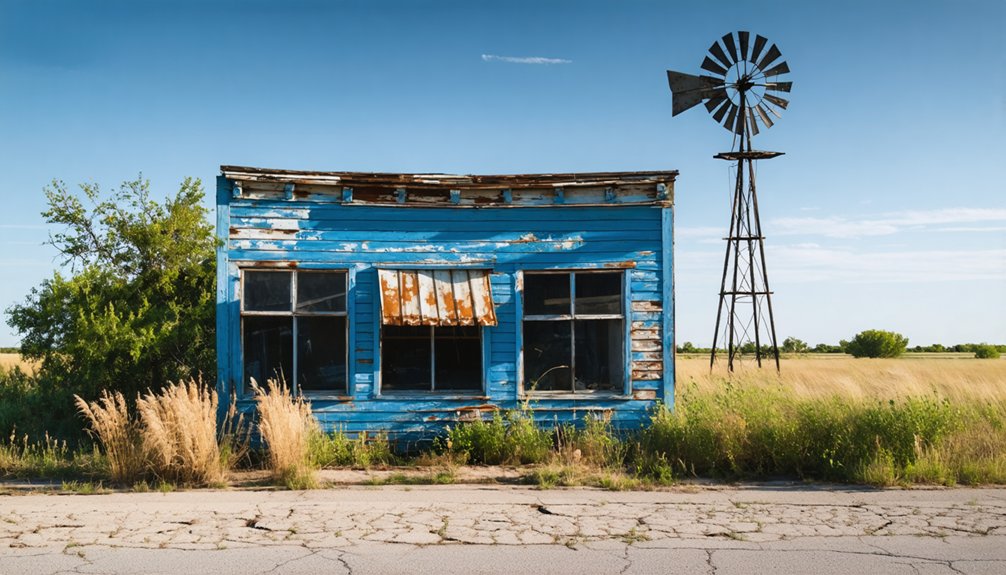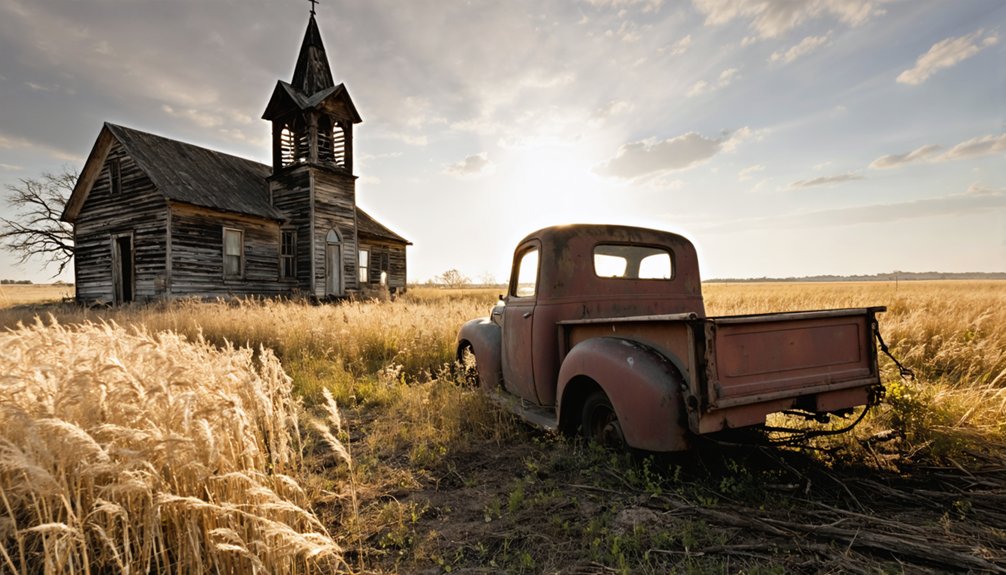You’ll find Morales in Jackson County, Texas, where it emerged as a frontier settlement in the late 1840s around a blacksmith’s shop. The town flourished with abundant wells and ranching before facing post-Civil War challenges and lawlessness. Though abandoned by 1940, you can still explore its historic cemetery, drought-exposed foundations, and a 4-foot concrete town well. The story of this ghost town reveals fascinating insights into Texas’s tumultuous frontier period.
Key Takeaways
- Morales was established in Jackson County, Texas during the 1840s and named after a local blacksmith before becoming abandoned by 1940.
- The town’s only remaining physical structure is a 4-foot concrete well, though drought reveals foundations of former buildings and businesses.
- A historic cemetery containing early settlers and freed slaves remains as tangible evidence of the community’s existence.
- Post-Civil War lawlessness, economic isolation, and inability to adapt to changing times led to the town’s eventual abandonment.
- Local preservation groups have worked since 1962 to document and preserve Morales’s history through various community initiatives.
The Rise and Fall of a Frontier Settlement
As frontier settlements spread across Texas in the late 1840s, Morales emerged in the sparsely populated ranch country of Jackson County. Named after a local blacksmith, the town experienced steady growth before the Civil War, maintaining a modest but stable community focused on ranching activities. Similar to towns like Lobo, water availability from abundant wells attracted early farmers and ranchers to the region.
You’ll find that Morales’s promising start was cut short by significant frontier challenges during Reconstruction. Lawlessness overtook the town, driving away potential settlers and deterring railroad companies from laying planned tracks. The town survived in this unstable state until its final decline in 1940.
Without crucial rail connections, the settlement’s economic decline became inevitable. The town’s isolation from regional trade networks sealed its fate.
Lawlessness in Post-Civil War Texas
When the Civil War ended in 1865, Texas plunged into a period of unprecedented lawlessness that would define the next several decades.
You’d have found a state in chaos, with dismantled government institutions and overwhelmed courts struggling to maintain order. Criminal enterprises flourished across the region, from cattle rustling to train robberies, while personal vendettas erupted into deadly feuds. The growth of the profitable cattle trade industry in the 1870s made livestock an especially attractive target for rustlers. Civil law enforcement proved largely ineffective, with many local officers secretly supporting outlaw activities.
In the absence of effective law enforcement, you’d have witnessed the rise of vigilante justice. Armed groups, including the Ku Klux Klan, terrorized Union supporters and Black citizens, particularly east of the Trinity River.
Even the Texas Rangers, meant to restore order, often engaged in controversial tactics, especially during border conflicts with Mexico. Local officials either participated in or turned a blind eye to the violence, creating a dangerous climate where might made right.
The Morales Family Legacy
The remarkable story of the Morales family legacy begins with Meliton Morales, born in 1836 during Texas’ fight for independence.
After being captured by Apaches at age seven and later traded to the Delaware tribe, young Meliton escaped as a teenager and made his way to Texas, where he’d later serve in the Union Army during the Civil War. His journey included reaching Fort Leavenworth in Kansas with a fellow escaped captive.
The Morales heritage flourished as the family established a significant ranching empire, shaping Jackson County’s agricultural development. Like the legendary safe river crossing at Plemons, the Morales ranch became a crucial waypoint for regional travelers.
Their influence extended beyond ranching, as family traditions and stories of frontier life became woven into Texas folklore.
Today, you’ll find Morales descendants actively preserving their history through social media networks and genealogical research, while a Texas historical marker stands as a tribute to Meliton’s pioneering spirit and the lasting impact of this remarkable frontier family.
Physical Remains and Archaeological Evidence
You’ll find the most prominent physical remains of Morales in its historic cemetery, where tombstones like Johnny Parks’ mark the final resting places of freed slaves and early settlers.
The drought-exposed foundations near the lake reveal concrete remnants of a two-story hotel, a cotton gin scale, and what appears to be an old Texaco station. The water levels dropping have made these historical structures more visible than they’ve been in decades.
The tallest surviving structure is a 4-foot concrete town well, though many sites remain inaccessible due to protective fencing and no-trespassing signs around the ruins. Similar to Shafter’s cemetery with its two thousand graves, the burial grounds serve as a haunting reminder of the town’s once-thriving population.
Cemetery and Burial Grounds
Located on rocky terrain near the abandoned settlement, Morales Cemetery stands as a physical tribute to the town’s history, containing burials spanning from early 1900s settlement through 1940s abandonment.
You’ll find burial customs adapted to the challenging landscape, with bodies laid to rest under rounded stone piles due to the rocky soil. The grave markers tell stories through homemade crosses, simple stonework, and folk art that reflects the deceased’s personality. The site preserves the legacy of those who perished from mercury poisoning deaths during the mining operations. Today, visitors often leave personal tokens like beer bottles and CDs at the gravesites.
Archaeological evidence reveals a diverse community of miners, laborers, families, and indigenous peoples.
You can spot remnants of company-made coffins from mining accidents, while personal tokens like rosaries and cultural items paint a picture of the mainly Hispanic population.
The cemetery’s unmarked graves and makeshift memorials provide valuable insights into the lives of marginalized and transient residents.
Building Foundations and Rubble
While decades of abandonment have taken their toll, physical remains at Morales consist primarily of scattered stone foundations and building rubble across the former settlement site.
You’ll find evidence of simple frontier architecture through locally sourced foundation materials like stone and basic mortars, typical of late 19th-century rural Texas construction. A stone house built by Meliton Morales in 1881 nearby confirms the prevalent use of these materials in the area’s architectural styles.
The foundations suggest modest residential or ranch structures, now reduced mainly to ruins. Though no complete buildings survive, you might discover fragments of glass, pottery, and nails among the rubble – common artifacts that help date the settlement’s occupation and abandonment around 1940.
Historical Significance in Texas Settlement Patterns

As one of Jackson County’s oldest communities, Morales exemplifies the complex dynamics of early Texas settlement patterns during the Republic era. The town’s evolution from Santa Anna to Morales reflected the rich cultural influences of the Mexican-Texan borderlands.
You’ll find Morales’ story mirrors many frontier settlements that struggled to survive:
- Early promise as a ranching community in the 1830s-40s attracted settlers seeking opportunities in Texas’ open ranges.
- Post-Civil War lawlessness deterred vital railroad development and economic growth.
- Loss of transportation routes isolated the community from expanding market economies.
- By 1940, the town succumbed to the fate of many settlements that couldn’t adapt to changing times.
The town’s rise and fall demonstrates how infrastructure access and social stability determined which Texas settlements would thrive or fade into history.
Preservation and Documentation Efforts
Recent preservation initiatives have breathed new life into Morales’s remaining structures and historical legacy. Since 1962, you’ll find dedicated community engagement through local preservation groups working to save the town’s courthouse and other key structures. They’ve modernized buildings with amenities like air conditioning while maintaining historical authenticity.
The town’s preservation approach combines physical restoration with robust archival strategies. You’ll discover detailed documentation through video histories, photo collections, and oral narratives from descendants.
Local volunteers coordinate hands-on workshops for adobe restoration, while creating interpretive signage to enhance visitor experience. Legal protections, including Historic and Cultural Landmark designations, now safeguard these efforts.
The community’s focus on educational outreach guarantees Morales’s story continues through school visits and genealogical research.
Frequently Asked Questions
Are There Any Documented Supernatural Occurrences or Ghost Stories From Morales?
Despite a history of 27 documented vigilante killings, you won’t find official records of ghost sightings in Morales. The haunted history remains confined to local oral traditions and unverified family tales.
What Was the Peak Population of Morales During Its Most Active Period?
You’ll find no exact peak numbers documented, but considering the population decline and historical significance, the settlement likely never exceeded 100 residents based on its 65-person count in 2000.
Were There Any Notable Businesses or Industries Operating in Morales?
Ever wonder about Morales’ commerce? You won’t find many historic landmarks, as lawlessness prevented major businesses from establishing. Local legends suggest ranching activities dominated, but no significant industries took root without railroad access.
How Accessible Is the Cemetery Site to Modern-Day Visitors?
You’ll find the cemetery accessible via Luthe and Buschong Roads, though visitor experience is basic with no formal facilities. You can visit freely, but expect uneven terrain and primitive conditions.
Did Any Famous Historical Figures Ever Visit or Stay in Morales?
You won’t find any globally famous figures in Morales’s history, though you’ll discover the Dalton Boys once passed through during a revival, and notable residents like Rev. Johnny Cook and rancher W.W. Moore made their mark.
References
- https://www.ghosttowns.com/states/tx/morales.html
- https://www.texasstandard.org/stories/when-lobos-water-dried-up-it-took-the-west-texas-town-with-it/
- https://en.wikipedia.org/wiki/List_of_ghost_towns_in_Texas
- https://www.texasescapes.com/TexasHillCountryTowns/Cleo-Texas.htm
- https://texashistory.unt.edu/ark:/67531/metapth87359/
- https://www.tshaonline.org/handbook/entries/morales-tx
- https://www.texasescapes.com/TexasHillCountryTowns/Morales-Ranch-Texas.htm
- https://texapedia.info/wild-west-history/
- https://www.americanyawp.com/reader/reconstruction/general-reynolds-describes-lawlessness-in-texas-1868/
- https://digital.library.unt.edu/ark:/67531/metadc663776/m2/1/high_res_d/1002774009-Keener.pdf



